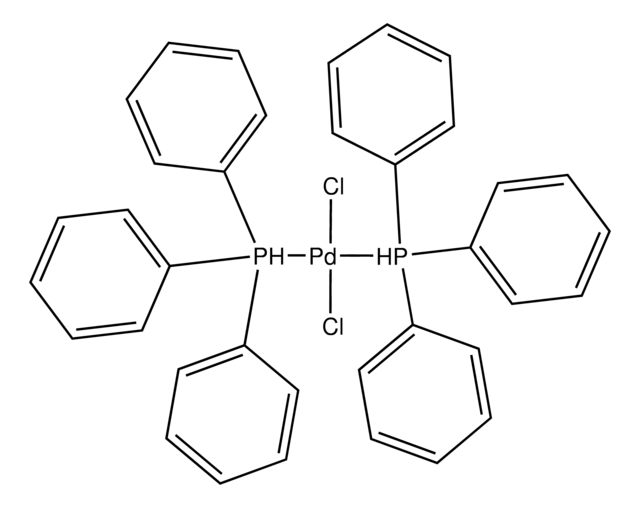We would recommend using a metallic scavenger like the QuadraPureTM products. Product numbers 655422 and 657662 are designed to scavenge palladium ions and are effective in both acidic and basic conditions. The resins are capable of removing metallic contamination to very low levels and are ideal for pharmaceutical or fine chemical processing.
Wichtige Dokumente
520764
[Pd(OAc)2]3
≥99.9% trace metals basis
Synonym(e):
Pd-(OAc)2
Größe auswählen
Größe auswählen
About This Item
Empfohlene Produkte
Qualitätsniveau
Assay
≥99.9% trace metals basis
Eignung der Reaktion
core: palladium
reaction type: Buchwald-Hartwig Cross Coupling Reaction
reaction type: Cross Couplings
reaction type: Heck Reaction
reaction type: Hiyama Coupling
reaction type: Negishi Coupling
reaction type: Sonogashira Coupling
reaction type: Stille Coupling
reaction type: Suzuki-Miyaura Coupling
reagent type: catalyst
reaction type: C-H Activation
mp (Schmelzpunkt)
216.3-223.7 °C (dec.)
SMILES String
CC(O[Pd]OC(C)=O)=O
InChI
1S/2C2H4O2.Pd/c2*1-2(3)4;/h2*1H3,(H,3,4);/q;;+2/p-2
InChIKey
YJVFFLUZDVXJQI-UHFFFAOYSA-L
Suchen Sie nach ähnlichen Produkten? Aufrufen Leitfaden zum Produktvergleich
Allgemeine Beschreibung
Anwendung
- Bildung von Allylacetaten.[5] (eq. 1)
- Hydroselenierung von Dreifachbindungen.[6] (eq. 2)
- Heck-Arylierung von Alkenen.[7] (eq. 3)
- Cyclocarbonylierung.[8] (eq. 4)
- Aminierung durch Buchwald-Hartwig-Kupplung.[9] (eq. 5)

Für kleinformatige und Hochdurchsatz-Anwendungen ist das Produkt auch als ChemBeads erhältlich (924377).
Ähnliches Produkt
Signalwort
Danger
H-Sätze
Gefahreneinstufungen
Aquatic Acute 1 - Aquatic Chronic 1 - Eye Dam. 1 - Skin Sens. 1A
Lagerklassenschlüssel
11 - Combustible Solids
WGK
WGK 2
Flammpunkt (°F)
Not applicable
Flammpunkt (°C)
Not applicable
Persönliche Schutzausrüstung
dust mask type N95 (US), Eyeshields, Gloves
Hier finden Sie alle aktuellen Versionen:
Analysenzertifikate (COA)
Die passende Version wird nicht angezeigt?
Wenn Sie eine bestimmte Version benötigen, können Sie anhand der Lot- oder Chargennummer nach einem spezifischen Zertifikat suchen.
Besitzen Sie dieses Produkt bereits?
In der Dokumentenbibliothek finden Sie die Dokumentation zu den Produkten, die Sie kürzlich erworben haben.
Kunden haben sich ebenfalls angesehen
-
When using are Product 520764, Palladium (II) acetate, what can I use to remove traces of palladium that this catalyst may leave behind?
1 Antwort-
Hilfreich?
-
-
What reactions are Product 520764, Palladium (II) acetate, used in?
1 Antwort-
Palladium (II) acetate is used as a catalyst for a number of reactions, including: Suzuki coupling reactions, (See ChemFiles 2.1 and ChemFiles 4.2) vinylation, (i.e. the Heck Reaction), rearrangement of acyclic dienes (i.e. the Cope Reaction).Papers that cite the use of this reagent are listed below. 1. B.M. Trost Tet. 33, 2615, (1977)2. R.F. Heck Acc. Chem. Res. 12, 146, (1979)3. Tet. 62, 9002, (2006)4. Org. Lett. 8, 3311, (2006) abstract5. Organometallic News 2, 52, (2002)
Hilfreich?
-
-
What atmosphere is Product 520764, Palladium (II) acetate, packaged under?
1 Antwort-
This material is packaged under a layer of nitrogen to reduce the chance of moisture contamination.
Hilfreich?
-
-
What is Product 520764, Palladium (II) acetate, soluble in?
1 Antwort-
Palladium acetate is not water-soluble; it is organic soluble. Although Sigma-Aldrich does not test solubility of 520764 directly, it is expected to be soluble in most common organic solvents, like chloroform, methylene chloride and acetone, according to the manufacturer.
Hilfreich?
-
-
What is the difference between Product 520764, Palladium (II) acetate, and the palladium acetate in the form of a ChemDose® tablet?
1 Antwort-
The ChemDose® products offer a streamlined way to catalyze reactions. The catalyst is dispersed in an inert tablet matrix in specific millimolar and micromolar quantities. The tablets can decrease time spent on weighing/adding the catalyst to the reaction mixture. The tablets effectively give the same reaction yields with a controlled release of the catalyst. They are also extremely easy to remove after the reaction is complete. The inert tablet usually stays intact throughout the reaction. Product 684929 is the ChemDose® tablet that contains 2.0 μmol of palladium (II) acetate, while product#: 685593 is the 10μmol version. More information on these products can be found at the link below.
Hilfreich?
-
-
What is the Department of Transportation shipping information for this product?
1 Antwort-
Transportation information can be found in Section 14 of the product's (M)SDS.To access the shipping information for this material, use the link on the product detail page for the product.
Hilfreich?
-
Aktive Filter
Unser Team von Wissenschaftlern verfügt über Erfahrung in allen Forschungsbereichen einschließlich Life Science, Materialwissenschaften, chemischer Synthese, Chromatographie, Analytik und vielen mehr..
Setzen Sie sich mit dem technischen Dienst in Verbindung.![[Pd(OAc)2]3 reagent grade, 98%](/deepweb/assets/sigmaaldrich/product/structures/508/249/99a0ef2c-b77c-4d73-8ed9-0cca05b6b41f/640/99a0ef2c-b77c-4d73-8ed9-0cca05b6b41f.png)








![[Pd(acac)2] Umicore, 99%](/deepweb/assets/sigmaaldrich/product/structures/145/685/c3d0f078-c0c6-4ce6-9c4a-b6a1b973b3a9/640/c3d0f078-c0c6-4ce6-9c4a-b6a1b973b3a9.png)


